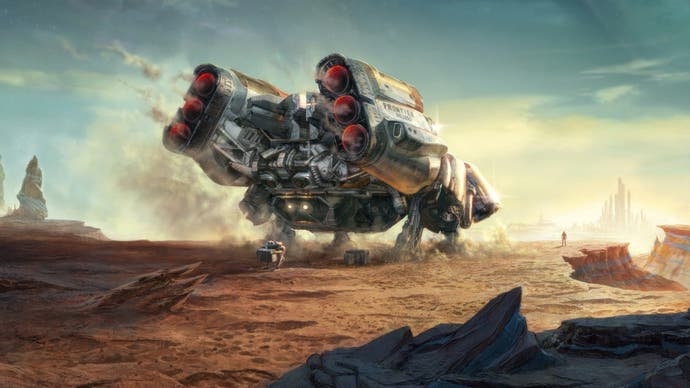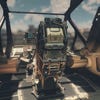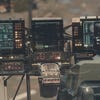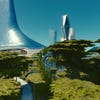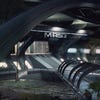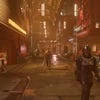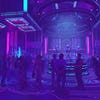Starfield: the Creation Engine evolves to deliver massive ambition, scale and scope
The Digital Foundry tech review.
Space - the final frontier - an infinite playground shrouded in mystery and intrigue. Since the launch of Sputnik 1 in 1957, mankind has yearned to deepen our understanding of the cosmos - to explore the outer reaches of space. This infatuation with interstellar travel would manifest throughout literature and film in the years that followed but it is arguably the video game that shares the deepest connection with outer space. 1962's Spacewar, one of the earliest video games ever created, was built on this desire to dance among the stars. It was just the beginning. Now, 61 years later, those dreams of electronically powered galactic exploration have reached a new milestone with the release of Starfield.
Starfield is built on the latest iteration of Bethesda's in-house technology - known as Creation Engine 2, an updated iteration of their technology foundation boasting many improvements to facilitate the firm's most ambitious game yet. Featuring more than a thousand planets, Starfield is a rich space exploration RPG that builds on the concepts forged in Bethesda Game Studios' previous works while taking the scope to a new level. You'll travel across countless systems and planets, exploring a wide range of settlements, cities, and desolate plains in the process.
As promised, this is an exceptionally large game. Starfield opens with a sequence introducing players to key gameplay concepts, before introducing Constellation, an organisation united by a desire to unravel the mysteries of the universe. It isn't long until you're handed full control and begin your journey across the galaxy, a process that immediately answers key questions about how the game manages structure and scope. Your ship serves as the central pillar on which everything is built, shuttling you between worlds and serving as home to your crew. You'll access the star map from your ship, plotting courses to various planets across multiple systems. As the game progresses, you can build out your ship to create something far larger, but its purpose remains the same - it's the glue between worlds.
This ties into one of the game's notable limitations - planets and outer space are separate entities divided by loading screens - Bethesda was up-front about this in previews, but it is not a seamless experience. You can, at least, observe the exterior of a planet or open space from within the ship but transitioning to the surface requires a short loading screen. Each planet and indeed outer space itself is divided up into bespoke sections, which perhaps explains how so much intricate detail is delivered.
The ship itself is an excellent starting point for appreciating the level of detail on display in Starfield. Granular visual nuance has not been a strong point for Creation Engine in the past, but the level of detail significantly increases in the new game. Zoom in on any control panel or surface and there's an impressive level of granularity on display. Every single button, switch, or knob is fully modelled with high-resolution textures that indicate its purpose. It is ultimately little more than background noise, but it contributes greatly to immersion. This is further enhanced by a vastly improved physically-based materials pipeline - metal, plastic and the like all look remarkably tactile. There's so much nuance packed into such a small space and I was genuinely surprised by the leap in fidelity.
Once you've absorbed the ins and outs of your ship, however, the choices are vast - and this is exactly what sets Starfield apart from previous Bethesda games. Fundamentally, it's about variety. In a game like Skyrim or Fallout, players are confined to a somewhat repetitive environment - you'll spend time in aesthetically similar locations from start to finish. With Starfield, Bethesda can go beyond that.
Many planets have drastically different cities and environments to explore compared to the other locations. New Atlantis, for example, is the first major city you'll visit. It features glass structures towering above the player, with manicured gardens and vegetation filling in the gaps. It's a bustling place, reminiscent of the Citadel in Mass Effect.
Venture forward, however, and you'll find vastly different locales. Take Akila, for instance, which is a rundown, walled Old West-style town with high-tech flourishes. This bustling oasis serves as a base of operations for the Freestar Rangers and boasts an ambience that differs completely from New Atlantis. Impressively, the level of detail observed in your ship remains high even when exploring various installations. Myriad props scattered around every environment lend it that lived-in feel - and each of them are highly detailed when examined. The interior spaces themselves look great too. It's a gigantic leap over any prior Bethesda game.
Then there's Neon - a cyberpunk-esque city decked out with blinding signage, huge crowds and nightmarish, metallic structures choked by cables. The entire city is built on an otherwise deserted planet of water held high on sturdy pylons. It's a location quite unlike anything else ever featured in a Bethesda game and fills the role of an underground criminal paradise.
Cities like Neon also rely heavily on reflections to sell the effect, with the variable roughness of the water soaked materials influencing the look. Mirror-like puddles combine with rougher cement and metals to create convincingly damp surfaces. It also reveals that Bethesda is relying entirely on cube maps rather than screen-space reflections, planar or ray traced reflections.
In many scenes, cube maps are aligned within the scene to reflect the surroundings and create a more coherent image. It works in a city like Neon but if you jump back to, say, New Atlantis, the limitations become obvious - reflections across water, for instance, rarely line up with the scenery and completely omit dynamic objects. Water does not seem to have been radically improved over prior Creation Engine titles, especially at a distance.
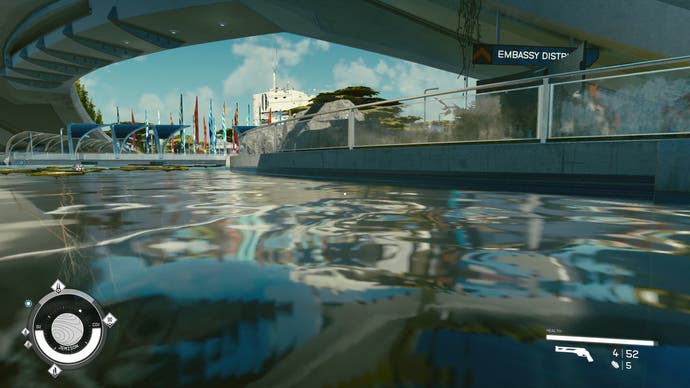
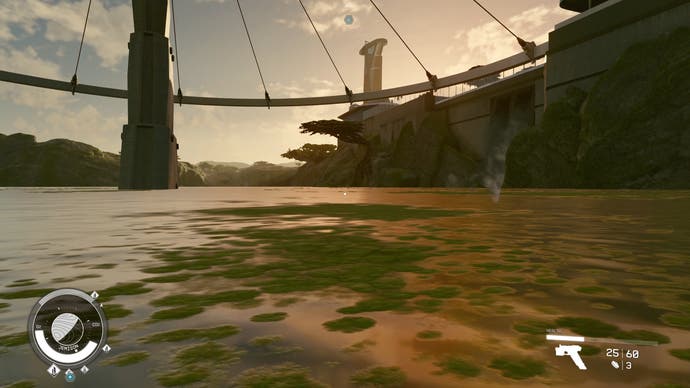
Within these cities, you'll engage with a wide range of characters. This has always been an area of weakness for Bethesda Game Studios but improvements have certainly been made. When engaged in conversation, the camera focuses on the speaking character while background elements appear out of focus using a gorgeous bokeh depth of field effect. Facial animation is fairly basic but it gets the job done. Examining character detail up-close, however, reveals an impressive array of details crafted into their outfits - especially in characters donning space suits. The physically-based materials really shine lending the game an additional sense of realism. So while animation isn't especially impressive, the actual level of detail is.
That said, perhaps unsurprisingly, NPCs wandering around the game world are less impressive, to say the least. The actual geometric detail is ample but the lighting and lack of subsurface scattering don't hold up in practice. Still, the NPCs fulfill the role of creating an illusion of a bustling city environment which is their purpose.
Of course, as a Bethesda game, it's no surprise that character creation is a large focus. The system here is indeed very flexible - Fallout 4 offered a tactile approach which has you directly manipulating facial features but with the increase in number of variables, Starfield shifts back to a menu driven design which allows far more subtle adjustments. The hair, clothing and skin rendering, while not cutting edge, do look great overall which is a big step forward for a game like this.
Where Starfield differs most from its BGS predecessors lies in how its environments are presented to the player. Each major city or settlement occupies its own planet rather than being situated within a singular, seamless world - you can't simply walk from New Atlantis to Akila for obvious reasons; they're on different planets!
When visiting these settlements, however, you are not confined to the city itself - it's possible to leave the city limits and explore the surrounding planet, but by dividing up these zones, most of each planet remains relatively sparse which is a shift in design from prior Bethesda games. You may uncover additional locations ranging from research stations, abandoned factories or any number of other places. Quests, resource gathering, and base building are all designed to take advantage of these planetary landscapes.
Environments and how they are lit are a crucial element of the game's aesthetic. There are, supposedly, more than 1000 planets in this game but all of them rely on the engine's new visual features to build atmosphere. The single largest improvement stems from volumetric effects - it's used effectively in cities, of course, but it also helps shape the terrain before you thanks to pockets of height fog filling the valleys. Most planets seem to rely on procedurally generated terrain that produces a decent variety of locales. There are steep mountainous areas reminiscent of Skyrim but also flat, desolate moons and deserts or ice planets. Variable weather and time of day both influence the presentation: sometimes clear views are possible, other times it's concealed by fog.
Crucially, objects such as rocks, trees and structures remain largely visible at a distance but there is some mild pop-in. If you watch closely, you'll certainly notice elements such as grass popping into view, much like most other open world games. Still, the view distance feels as if it's been pushed out a great deal since Bethesda's prior games.
Starfield also has a new global illumination solution that seeks to accurately render light bounce. For example, rocks may take on an orange hue as the sun bounces off similarly coloured soil - or you may note a star radiating blue light, subtly illuminating the surface of a nearby moon. There's no real-time per-pixel ray tracing in effect, but the solution used here is still reasonably effective at handling indirect lighting within shadowed regions. Unfortunately, there are plenty of areas where this doesn't fully hold up to scrutiny with shadowed regions appearing overly bright instead, but this is to be expected with a non-RT solution. Maybe someday we'll see ray tracing added in Starfield: Special Edition?
In addition to the global illumination solution, the resolution of the textures is also excellent for the most part, and materials work is largely well done. I would say metals, leather and stone fare best in this regard. More natural materials are perhaps a little less realistic to the eye, though, and the quality can vary per environment to some degree.
Post-processing effects deserve a special mention given how prior titles were weak in this area. Bokeh depth of field is pleasing realised as I hope the video above demonstrates, but it deserves a second mention because it looks so nice. It's not only used in conversations, but also when looking down the sights of your weapon and can be used a lot in photo mode.
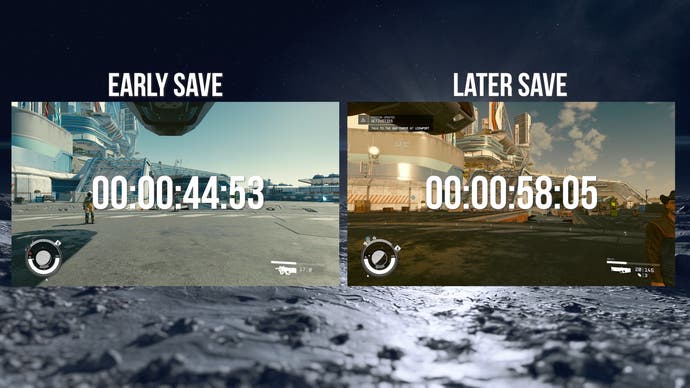
More importantly, Bethesda worked with id Software to implement a new per-pixel motion blur - something absent in every other Creation Engine game. Given that it's a 30 fps game on Xbox, this is critical as it greatly improves the perception of fluidity, even at a lower frame-rate. I would have liked to see a shutter-speed adjustment in the options menu as it's a little on the light side but it still contributes greatly to the presentation. For the heathens, though, you can disable it - and the same applies to film grain too.
Of course, while Starfield generally looks impressive, it isn't always pristine. Much of this comes down to the scope of the game: with so many planets and a heavy reliance on procedural generation, it's no surprise that you can poke holes in the presentation from time to time. And there are areas near major cities that feels slightly undercooked. Case in point: if you leap down into the water surrounding New Atlantis to observe the waterfalls you might notice an unusual mist effect exhibiting obvious sorting issues. In fact, this specific area around the city is lacking in detail and when combined with the basic cube map reflections on the water, it feels slightly out of place.
The water also surprises me - there is no swimming in Starfield. The water will break your fall if you jump from a great height, but diving is forbidden. You just glide along the surface like a guppy out of the water. Still, when looking across the game, I feel that Bethesda has done a commendable job with the visuals. From a pure rendering standpoint, Starfield isn't cutting edge, but the team has managed to create something that I would genuinely call beautiful for much of its duration.

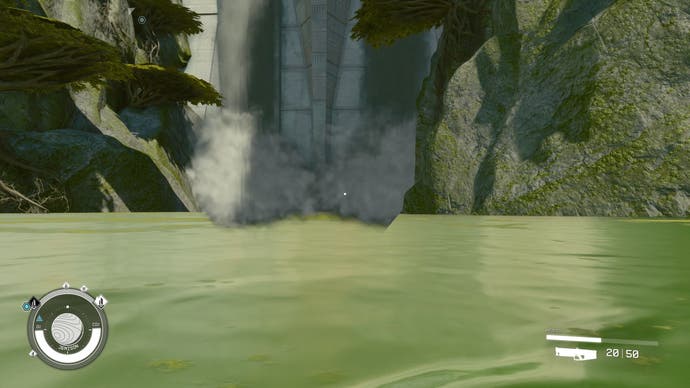
Moving away from visuals and looking at basic structure, I think it's important to stress that Starfield is not a space exploration game in the style of Star Citizen or No Man's Sky. Here's how a small slice of gameplay strongly emphasises this state of affairs. Beginning at Constellation HQ, I selected a mission on planet Akila. As I left the compound, there's a loading screen as we enter the New Atlantis cityscape. Now, we're heading for the tram station to take us to our ship. Select your destination and there's another loading screen. However, it is possible to reach the space port on foot using some acrobatic skills so this loading screen amounts to fast travel, basically.
Once on the ground level, we find our ship and upon arrival, another brief loading screen awaits us as we transition to the ship interior. From here, we can jump behind the controls and take off. After another loading screen, we find ourselves suspended above the planet from which we departed and an objective marker. This is the first reality of space travel in Starfield. The game loads a small zone around the player with a variety of interactive elements such as hostile and friendly vessels, asteroids and space stations. However, visible planets are a mere illusion as you cannot travel between two points in space. To visit any other planet requires you to utilise the galaxy map system where you point to a place of interest and initiate fast travel.
It's a curious thing. On one hand, the feeling of taking a journey across the stars is largely absent as reaching any destination is simply a click or two away via the map system. There's no sense of space exploration here - it's about the destination, not the journey. Yet, in reality, space travel would largely be devoid of anything interesting, the act of flying to another planet would result in severe boredom. I do wish a middle ground had been established, something that captures the sense of exploring distant planets without the reality of interstellar travel.

I should also note that the galaxy map is always one click away. Going all the way back to Constellation HQ, I didn't need to walk all the way to my ship - I could just as easily have brought up the menu, selected my destination, and touched down within seconds. It does spoil the perception of distance between planets, but there are benefits to the design. Item persistence is the big one: the game tracks the state of many things across the game world, from the position of doors, location of items and even the bodies left behind after a fire fight. To see just how persistent it is, I stacked up some soap bottles in a toilet, completed a few missions and visited a total of ten different worlds. Returning to the toilet, those soap bottles were just as I had left them. This is one element that separates a BGS title from the rest.
One last thing I should mention is the limitations on exploration. No, you cannot walk around an entire planet. When you land, the game seems to generate a large area for the player to explore but if you walk too far in any direction, you're stopped in your tracks. It's a little jarring at first but, honestly, there isn't much of a reason to venture out across planets - that's just not what Starfield is about. So, on paper, Starfield functions much like any other Bethesda game with lots of segmentation. It only feels more egregious due to the increased frequency of fast travel and loading screens.
Unlike prior Bethesda games, however, is the level of polish and consistency in performance. We've already talked about this. Yes, there are hiccups in major cities but it's largely a stable 30 frames per second. I did notice that engaging in combat can exacerbate these drops too but again, it's still far beyond anything Bethesda has shipped on consoles in the past.
The other note on performance centres around loading times. After playing Starfield for nearly 30 hours, I found that loading times between areas had slightly increased since I first began playing. Remember the loading tests from earlier? Those same loading times are faster on average using a clean save. This is not unexpected behavior (perhaps tracking persistence involves storage) but I will be curious to see how much this changes as I play further in the game.
The other technical issue that requires some work is its HDR implementation. The game natively supports HDR but its peak brightness is severely limited while black levels are raised. In fact, black levels are raised in both SDR and HDR leading to a slightly washed out image. I suspect this is an intentional choice on the part of the developers but I would like to see an option in the menu allowing users to adjust the peak brightness, paper white and black levels to match their display. I was also disappointed by the lack of a field of view slider on any platform - though on PC, it's possible to change this setting via an .ini file. Classic Bethesda.
Still, despite these criticisms, I was really surprised and impressed by how stable the game is overall. 30 fps is not a high frame-rate, I get that, but it's almost always stable and that counts for a lot. I also want to give special mention to the game's audio. For starters, Inon Zur composed the soundtrack to Starfield and it's absolutely phenomenal - hugely atmospheric with powerful themes driving the experience, but the sound effects work is also equally impressive. It makes full use of surround sound, enveloping you in the action. However, what I really love are the ways in which sound playback varies per environment. The difference in weapons fire audio within an internal and external environment is huge.

So, what about the game in general? Starfield is a Bethesda RPG at its core - as you'd expect. In practice, it feels like a perfect blend of something like Skyrim or Fallout combined with the original Mass Effect. It's driven by a huge selection of interesting and often unexpected quests. Land on an empty planet and you may end up stumbling on events that lead to entire quest lines. Breaking up the game world into planets also means increased variation in the types of environments you'll play in - taking a mission on a rocky planet feels very different from infiltrating a base, for instance.
I've often taken issue with open world games and the endless amount of traversal they involve but weirdly enough, Starfield's segmentation (and yes, its loading) addresses this issue and it means you spend more time doing more interesting things instead. That's not to say you can't go off and explore if you want, but simply running across a landscape over and over again isn't the primary goal.
There's a lot more to discuss about Starfield and the Digital Foundry team are likely to get together to film a DF Direct Special on the game, along with some initial thoughts on the PC version while Alex Battaglia works on the full tech breakdown. We've also had the game working on the AMD 4800S Desktop kit, built around the Xbox Series X CPU. The complexity of the game and the corresponding CPU burden suggest that a consistent 30fps target was the right approach, for launch at least, but perhaps the headroom is there for some kind of performance mode, at least designed to work with VRR displays... and I wouldn't be surprised if this were added at a later date.
